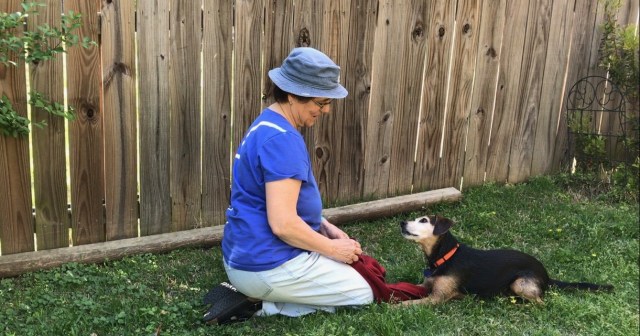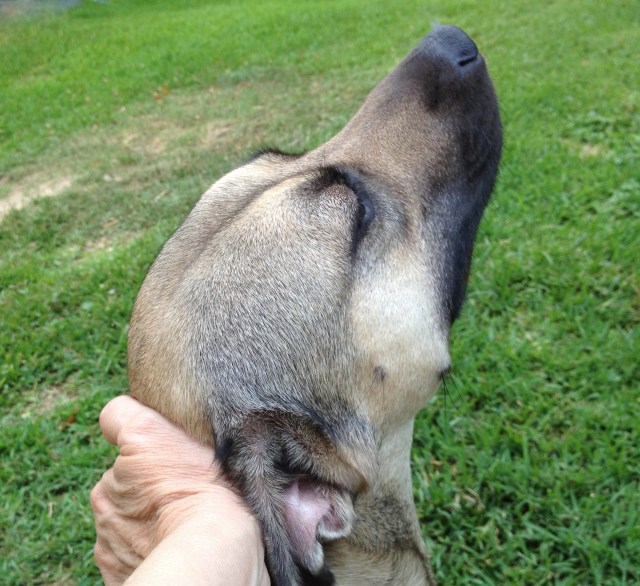Barks Blog
Actually, I **Can** Get My Dogs’ Attention
I was thinking the other day about how and why I have a dream relationship with my dogs. They are cooperative. They are sweet. They are responsive and easy to live with. You know how I got there? Training and conditioning them with food and playing with them.
They weren’t the most difficult dogs in the world when they came to me, but they weren’t easy, either. Clara was a feral puppy who was growling at every human but me when she was 10 weeks old. Zani is so soft and sensitive that she would have been considered “untrainable” by many old-fashioned trainers. Plus she’s a hound, and you know you can’t get their attention when there is a scent around.
Yeah, actually you can.
Getting the Dog’s Attention
I published a piece earlier this year about a certain claim that some force trainers make. The post is called “It’s Not Painful. It’s Not Scary. It Just Gets the Dog’s Attention!” I point out that a neutral stimulus that is not attached to a consequence can’t reliably get a dog’s attention, even though many trainers make that claim. A truly neutral stimulus will fade into the background, meaningless. And if there is no promise of a pleasant consequence attached to the attention-getting stimulus, trainers who claim success with it are using some kind of aversive method. You can’t get something for nothing.
This was not really news. It was just Post 3,197 trying to untangle some silly mythology about training.
But I’ve got something to add. If you do enough of the good stuff, you will likely find it easier and easier to get your dogs’ attention. For my dogs, there’s no such thing as a “neutral stimulus” coming from me anymore. For years I have reinforced everything I ask of them with wonderful consequences. So—don’t tell—but I do have the “magical attention signal.”
Presession Pairing
Agility great Susan Garrett calls it “Being the Cookie.” Bob Bailey might say you were inviting Pavlov to get permanently comfortable on your shoulder.
Applied behavior analysts call it presession pairing.
Huh?
That’s right. ABA folks have a process where the analyst deliberately gains rapport with her client, usually a child. She sets herself up as the source of all sorts of fun before a session starts. The “pairing” part of the term is not between the analyst and the client. It’s between the analyst and good stuff. In terms of classical conditioning, the analyst/trainer is setting herself up as a conditioned stimulus (like Pavlov’s buzzer, a predictor of intrinsically good stuff). In operant terms, she is becoming a secondary reinforcer.
This is a pretty readable scholarly review about it: Developing Procedures to Improve Therapist–Child Rapport in Early Intervention. In it, the authors operationalize some of the techniques that are used for presession pairing. (Despite the term, presession pairing doesn’t stop when the session starts. Most behavior analysts continue to do it whenever possible.) Some of the methods depend on verbal behavior, but several are rather familiar. I’m going to convert those to dog-talk.
- Imitating play that the dog initiates
- Offering items to the dog
- Creating a new activity with a toy.
Sound familiar? Of course, we would also add food, food, food! And petting, sweet talk, and cuddles with many dogs.
The advantages of gaining rapport with your client or your dog are pretty obvious. One advantage mentioned in the article stuck out to me, though:
Antecedent-based strategies can be used to reduce or eliminate the aversive nature of the therapeutic context (e.g., therapist and therapeutic setting).
This translates well to what we do, too. Training sessions are usually fun, but of necessity, we sometimes have to subject our dogs to unpleasantries. Shots, eye drops, trips to the vet. But if we set ourselves up as consistent givers of good things, we can help our dogs through these experiences with minimal stress. So making ourselves into a giant conditioned reinforcer is not a selfish thing to do. It’s not just about, “Yay, my dogs think I’m great and I can get them to do anything!” It also helps the dogs in a big way.
Too Clinical? Nope!
The section above may have halfway given some of you the creeps. If you are new to analyzing this stuff, it may feel bad, wrong, manipulative, unnatural—pick your word—to set out so deliberately to get somebody to like you. It might strike you as cold and clinical. But only if you haven’t done it before. Because once you do it, you realize there is nothing artificial about it. It feels good. It’s fun. It improves life for your dogs. I think it’s punishment culture that makes us feel weird about purposeful generosity and kindness. We can get over it.
 I have massively paired myself with good stuff over the years with my dogs. As a consequence, I don’t need any special interrupters around here. I don’t need to shake a can of pennies, throw something at the dogs, shock them, apply pressure, or yell. I don’t even need a “positive interrupter,” since that’s just another cue trained with positive reinforcement. I can say about anything to them and in just about any situation, they will reorient to me. Because even if it’s not one of their learned cues, if I’m talking to them, it’s likely that something fun for them will follow. And that’s pretty cool.
I have massively paired myself with good stuff over the years with my dogs. As a consequence, I don’t need any special interrupters around here. I don’t need to shake a can of pennies, throw something at the dogs, shock them, apply pressure, or yell. I don’t even need a “positive interrupter,” since that’s just another cue trained with positive reinforcement. I can say about anything to them and in just about any situation, they will reorient to me. Because even if it’s not one of their learned cues, if I’m talking to them, it’s likely that something fun for them will follow. And that’s pretty cool.
I’m interesting. I’m fun. It doesn’t take much for me to get my dogs’ attention.
Related Posts
- It’s Not Painful. It’s Not Scary. It Just Gets the Dog’s Attention.
- Using Annoying or Scary Sounds for Dog Training
- Classical Conditioning: Creating a Positive Response to Barking
Photo credit: Gingy Cookie from Wikimedia Commons, Copyright Jorge Barrios 2006.


